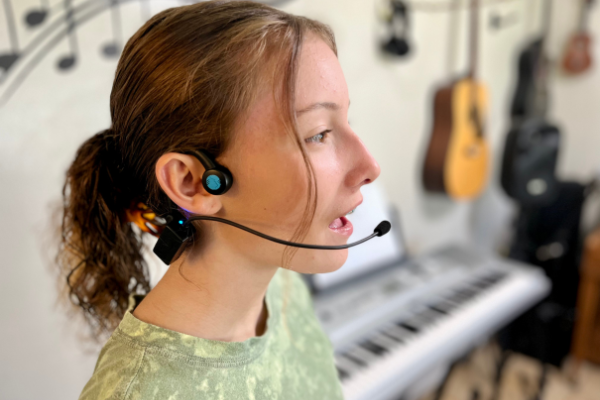Throughout my career of being a singing coach, I have heard singers all along the spectrum of pitch production. The end goal for most people is to sing “on key” or “in tune.” What does this mean and how do vocal coaches teach this to their students?
First, to sing “on pitch” means singing in the center of the note. Imagine pitch as a circle. Dead center is perfect pitch. Anything from center to the top of the circle is sharp; anything from center to the bottom of the circle is flat. But remember a sound produced anywhere in the circle is still the “right note” –just not perfect pitch.
My Forbrain Journey
Nine years ago, I began my research on how to improve pitch in singers. Parents or students would come requesting me to “fix their pitch” –meaning they sang sharp or flat. Previously, we could accomplish this by spending 3-5 years with aural exercises, interval training and shear exposure to correct sound. But there had to be a more efficient way. I developed a technique called Compression or Diaphragmatic Compression which enables a singer to limit the exact airflow needed to sing correctly. In some cases, the technique fixed-pitch deviations instantly. However, I knew there was a neurological component to singing in tune but had no way to incorporate this into my teaching.
Fast forward two years...when a package, from Forbrain, arrived at my studio for a microphone I ordered. Oh, it was so much more than a microphone! Never did I imagine how beneficial this would be in training singers. With a unique dynamic filter preparing the brain for sound before the ears pick up the sonic information, the Forbrain allows the student via bone conduction to recognize the audio-vocal loop more fully.
Using Forbrain's Audio-Vocal Loop
At the first introduction, I make sure students see my genuine excitement. I love microphones, so it is easy for me to express how amazing the Forbrain will help each student. Perhaps a singer is not singing on key. They can easily put the Forbrain on and adjust the microphone away from their mouth to their comfort level. I find students with absolute perfect pitch and/or sound sensitivities prefer the microphone further away than recommended 1.2 inches from the mouth.
We will work a specific vocal line or exercise a minimum of 3 times.
- The first time, the sound (vocal) stimulates sensory neurons (audio) which are processed in the
central nervous system (brain). - The second -or more- round of singing, the brain will make neurological changes if the pitch is incorrect and send motor neurons to modify the vocal chords/mouth/tongue where necessary.
- The third time, the brain and vocal track solidify the exact muscle placement and pitch awareness.
Working in the “making changes” phase, I like to see if the student’s ears, brain, and voice can modify the vocal tract first. Any pedagogical expert would agree that learning is best achieved when the learner can express the results themselves. However, when assistance is needed, I will sing the correct pitch(es) enabling the singer to hear my voice through their Forbrain. This allows them to compare a correct pitch with an incorrect one via their bone conduction.
Three activities for vocalists to do with Forbrain
- The student sings alone with the Forbrain
- The vocal teacher sings with the student together
- The teacher sings and then the student repeats.
Helpful with Harmonics
We have also found great success in the Forbrain while singing and playing an instrument like guitar or piano. This allows vocal harmonics to be in line with the instrument. I believe singing in tune is more than achieving a perfect fundamental note: all the note’s harmonics also must be perfectly centered. Singers and instrumentalists must hear the harmonics first. The Forbrain is a way to open the aural to the neural perception of these harmonics. Thus, in turn, leading the singer to a more perfect pitch.
My experiences and observations with Forbrain with students
- A teenager who can match pitch 30% of the time uses the Forbrain and in 30 minutes is matching 75% of the notes. This was incredible.
- A young male with ADHD sits still for 20 minutes and memorizes the words to a song he has never heard before. We were both amazed.
- A female with eustachian tube and inner ear congestion, who normally has good pitch, is very off-pitch. We put the Forbrain on her, to bypass her congested ears, and immediately her pitch returns to normal. In this situation, bone conduction is the principal role!
- While training singers to use a traditional dynamic cardioid microphone, we use the Forbrain simultaneously. Singers can process the sound coming from their voice AND monitor speakers via bone conduction. If you have never tried this, I highly recommend it! Using the Forbrain is helpful for performing musicians to work their live and studio microphones on a whole new level.
- A female in musical theatre uses the Forbrain, and diction becomes crisper and cleaner.
- An older teen male who tightens his jaw while singing uses the Forbrain and now jaw muscles align in the correct position.
- An adult female with perfect pitch uses the Forbrain to hear and decide which harmonics to amplify in the voice to create a more pleasing timbre (tone).
The Forbrain functions miraculously as I coach musicians to perfect their art. Just like we develop muscle memory to play instruments or sports, the Forbrain is a tool to help our vocal tract muscles recall what our brain is hearing and processing. This efficient coaching method to process sound is easy to use and good for our brain. Can anyone learn to sing on pitch? I believe if your brain can hear it, you can sing it.
Mindy Priestley
Vocal Coach and Director of Studio 220

.png?width=1900&name=blog_banner%20(1).png)

